MP Board Class 12th Economics Important Questions Unit 7 Determination of Income and Employment
Micro Economics Determination of Income and Employment Important Questions
Micro Economics Determination of Income and Employment Objective Type Questions
Question 1.
Choose the correct answers:
Question 1.
Income and employment are determined by:
(a) Total demand
(b) Total supply
(c) Total demand and total supply both
(d) By market demand.
Answer:
(c) Total demand and total supply both
Question 2.
The relation between consumption and savings are:
(a) Inverse
(b) Direct
(c) Inverse and direct both
(d) Neither inverse nor direct.
Answer:
(a) Inverse
Question 3.
When an economy their to save all its extra income then investment calculation will be:
(a) 1
(b) Uncertain
(c) 0
(d) Infinite.
Answer:
(a) 1
Question 4.
“Supply creates it own demand”. This statement was given by the economist:
(a) Keynes
(b) Pigou
(c) J. B.Say
(d) Adam Smith.
Answer:
(c) J. B.Say
Question 5.
Classical theory is based on the assumption of:
(a) Say’s law of market
(b) Flexibility in wage rates
(c) Flexibility in interest rate
(d) All of the above.
Answer:
(d) All of the above.
![]()
Questions 2.
Fill in the blanks:
- ……………………. refers to highest rate of return over cost expected from marginal or additional unit of a capital asset.
- Deflationary gap is the measurement of ……………………. demand.
- Deficit demand indicates ……………………. gap.
- In case of excess demand bank rate …………………….
- Multiplier can also ……………………. in opposite direction.
- The point at which aggregate demand and aggregate supply are equal is known as …………………….
- Unemployment is the result of …………………….
- Propensity to consume shows relation between ……………………. and distributed income.
Answer:
- Marginal efficiency of capital
- Deficit
- Deflationary gap
- Increase
- Work
- Effective demand
- Deficit
- Consumption
Question 3.
State true or false:
- Full employment does not mean zero unemployment.
- Increase in interest rate in future, will reduce the savings.
- Consumption expenditure does not increase in the same proportion as income increases.
- Theories of employment was propounded by Marshall.
- Unemployment is the result of deficit demand.
- Keynes theory also applies to underdeveloped countries.
- Keynes theory is based on the concept of full employment.
Answer:
- True
- False
- True
- False
- False
- False
- True.
Question 4.
Match the following:
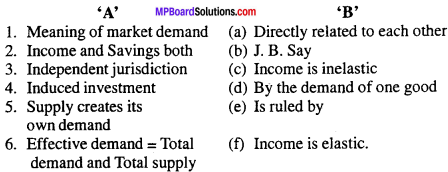
Answer:
- (d)
- (a)
- (c)
- (f)
- (b)
- (e).
![]()
Question 5.
Answer the following in one word / sentence:
- What will be the effect of multiplier, if multiplier leakage is high?
- Excess demand gives birth to?
- Which is the most appropriate measure to check deficit demand?
- Who propounded the deficit demand theory of unemployment?
- Name the interest theory propounded by Prof. Keynes.
- Which is the most effective measure to check it deficit demand?
Answer:
- Less
- Money inflation
- Increase in public expenditure
- Keynes
- Liquidity preference
- Increase in exports.
Determination of Income and Employment Very Short Answer Type Questions
Question 1.
What do you mean by marginal propensity to consume?
Answer:
Marginal Propensity to Consume (M.P.C.):
It refers to the ratio of change in the consumption to the change in income. It may be algebraically expressed as under:
![]()
or
M.P.C = \(\frac { ∆C }{ ∆Y } \)
Question 2.
What is meant by marginal propensity to save?
Answer:
Marginal Propensity to Save (M.P.S.):
It refers to the ratio of change is saving to a change in income. It can be obtained by dividing change in savings by change in income. Algebraically it can be expressed as:
![]()
M.P.S = \(\frac { ∆S }{ ∆Y } \)
Question 3.
What is the difference between actual investment and induced investment?
Answer:
Actual investment:
Actual investment refers to realizing investment. It is what the investors actually make at different levels of income and employment in the economy.
Induce investment:
Induce investment in that investment which depends on the expected profitability of level of income.
![]()
Question 4.
What is effective demand?
Answer:
Effective demand means that amount of money which people of a country spend on consumption and investment in a specific time. That level of demand is effective which is equal to aggregate supply. According to Keynes, “By point of aggregate demand at which the aggregate curve intersect the price at that point is called effective demand.”
Question 5.
Explain voluntary and involuntary unemployment.
Answer:
Voluntary:
It signifies the situation where in all the person willing to work at existing rate of remuneration are getting employment.
Involuntary:
It refers to that situation where in all the persons are willing to work at existing rate of remuneration do not get employment. It signifies the state where the available resources are not fully utilized.
Question 6.
Explain any two measures which can be taken to remove the excess demand (Write any two).
Answer:
Followings are the two measures to be taken to check the excess demand:
1. Bank rate:
The rate at which the central bank lends money to its member banks is called bank rate. In a situation of excess demand, the central bank should raise the bank rate.
2. Open market operations:
The buying and selling of government securities and bonds in the open market by the central bank are called open market operations. In the time of excess demand, central bank sells government securities to commercial banks or to their customers.
![]()
Determination of Income and Employment Short Answer Type Questions
Question 1.
Write the characteristics of traditional theory of income and employment.
Answer:
Followings are the characteristics of theory of income and employment:
1. Automatic balance between demand and supply:
According to J.B. Say, the supply creates its own demand. When goods are produced and supplied, it automatically creates demand for some other goods, the classical economists always believed in automatic full employment through the free play of market mechanism, the forces of demand and supply.
2. Idea of unemployment is baseless:
The classical economist were not scared of the problem of unemployment. There cannot be any involuntary unemployment in classical and neoclassical world. According to them excess production is impossible so there is no question of normal unemployment.
3. Non – Interference society:
According to traditional economists, if there is no interference of the government in the economy of a nation then the situation of unemployment will never rise. If the government interferes in the matters then unemployment will always arise.
4. Supply creates its own demand:
According to classical theory supply, creates its own demand. Supply leads to production, expenditure income and demand. Therefore aggregate supply becomes equal to aggregate demand.
Question 2.
Write assumptions of traditional theory or classical theory of income and employment
Answer:
Assumption of Classical theory: Followings are the assumptions of classical theory of economics:
- The economy enjoys the state of full employment as the aggregate demand is equal to aggregate supply.
- There is no saving in the economy as all that is earned is invested.
- There is free competition among the products and factors.
- There is always possibility of extension of market.
- There is end of interference of government and non – government and no protection is given.
- There is no accumulation of wealth.
- This theory works only when all the goods produced are sold in market.
![]()
Question 3.
What is unemployment according to Keynes?
Answer:
According to Keynes, there cannot be an automatic equality between aggregate demand and full employment. He holds the state of full employment rarely exits. It is possible that aggregate demand may full short of aggregate supply and state of full employment is disturbed. According to him there is a state of involuntary unemployment where able persons work at current rates of remuneration face unemployment. Unemployment exits due to lack of effective demand and lack of expenditure on consumption and investment.
Question 4.
What are the components of aggregate demand? Explain.
Answer:
Followings are the components of aggregate demand:
1. Household consumption demand:
In this category comes, the goods and services to satisfy their consumption needs. The aggregate consumption expenditure constitutes consumption demand. Household consumption depends on level of income.
2. Investment demand:
This component of aggregate demand comes from the business firms. Investment goods like machines, factory buildings are not demanded by household consumer but by business or firms.
3. Government demand for goods and services:
Like consumers and firms, government may also demand goods and services either for consumption or for investment purposes.
4. Net export demand:
To find out aggregate demand of a country items of net export demand is included in it. For this, import is subtracted from exports.
Question 5.
Write short note on:
- Full employment
- Under employment.
Or
What do you mean by full employment and under employment?
Answer:
Full employment:
The term “full employment” signifies the situation wherein all the persons willing to work at existing rate of remuneration are getting employment. Full employment never means zero unemployment.
Under employment:
It refers to that situation wherein all the persons are willing to work at existing rate of remuneration do not get employment. It signifies the state where the available resources are not fully utilized the aggregate supply of goods and services.
![]()
Question 6.
State measures to correct excess demand.
Answer:
1. Bank rate:
The rate at which the central bank lends money to its member banks is called bank rate. In a situation of excess demand, the central bank should raise the bank rate. Increase in bank rate will automatically lead to increase in banks lending rates to their borrowers. This, in turn, will reduce the volume of banks loans and advances. Consequently, expenditure on both consumption and investment is reduced.
2. Increasing the reserve ratio:
Reserve ratio refers to a minimum percentage of deposits of a commercial bank in the Reserve Bank. If the reserve ratio is increased it will reduce the credit creation capacity of the banks. When there is a situation of excess demand, central bank can increase this ratio and thereby cash resources of the banks can be reduced. This will force the commercial banks to contract credit.
3. Open market operations:
The buying and selling of government securities and bonds in the open market by the central bank are called open market operations. In the time of excess demand, central bank sells government securities to commercial banks or to their customers. This will reduce the cash reserves with the commercial banks directly and indirectly thereby affecting their capacity to make loans. It will reduce the cash reserves of the commercial banks.
4. Reducing credit inflation:
To reduce the excess demand or to reduce inflation it is essential to reduce credit inflation. By selling securities, by increasing bank rate by central bank credit inflation can be reduce. ‘
5. By taking old currency and circulating new currency:
In situation of excess demand the government cancel the old currency and in place of it new currency was introduced for circulation.
Question 7.
Distinguish between Aggregate Demand and Aggregate Supply.
Answer:
Differences between Aggregate Demand and Aggregate Supply:
Aggregate Demand:
- Aggregate demand is refers to the total volume of goods and services demanded in an economy in a year.
- It implies the total amount of expenditure incurred by the community on purchase of all goods and services.
- Aggregate demand and aggregate expenditure is the same thing.
Aggregate Supply:
- Aggregate supply refers to the total supply of goods and services in the economy in a year.
- According to classical concept aggregate supply is perfectly in elastic with respect to the price.
- According to Keynesian concept the aggregate supply is perfectly elastic with respect to price level.
Question 8.
Differentiate between Induced Investment and Autonomous Investment
Answer:
Differences between Induced Investment and Autonomous Investment:
Induced Investment:
- Induced investment is that investment which depends on the expected profitability of level of income.
- It is income elastic.
- This investment is generally made in private sector.
- Induced investment curve tends to move upwards indicating increased investment of the increased level of income.
Autonomous Investment:
- Autonomous investment is that investment which is not influenced by the expected profitability.
- It is not income elastic.
- This investment is generally made in public sector.
- Autonomous investment curve is a horizontal straight line parallel to X-axis. It indicating that autonomous investment is independent of the level of income.
![]()
Question 9.
Explain paradox of thrift.
Answer:
Paradox of thrift:
The paradox of thrift, in brief, states that the higher ratio of saving in an economy will create condition that result in a fall in aggregate savings. This can be explained as follows If all the people in the economy start saving more, the aggregate demand for consumption will decrease which will lead to low investment, low production and low income. Consequently the savings will reduce. This is known as paradox of thrift.
Question 10.
Are the following entered:
- On the credit side or the debit side and
- In the current accour or cap Hal account in the Balance of Payment account. You must give reasons for your
(a) Investments from abroad
(b) Transfer of funds to relatives abroad.
Answer:
(a) Investment from abroad:
Investment from abroad is a component of capital account. It comes on the credit side of capital account of balance of payment. It implies investment from abroad in shares of Indian companies, in Indian branches of foreign companies, in real estate, etc. It also includes repatriation of Indian investment abroad etc. These bring in foreign exchange.
(b) Transfer of funds to relatives abroad:
This is shown on the credit side of current account of balance of payment under the heading “invisibles” .Transfer means receipts/ payments between residents and non-residents for which the provider does not receive a quid proquo in return.
Question 11.
Measure the level of ex-ante aggregate demand when autonomous investment and consumption expenditure (A) is Rs 50 crores and MPS = 0 – 2 and the level of income (Y) is Rs 4000.00 crores. State whether the economy is in equilibrium.
Answer:
MPC = 1 – MPS = 1 – 0 – 2 = 0-8
AD = (C +1) + CY
= 50 + 0 – 8 x 4000
= 50 + 3200
= ₹ 3250
crores AS (Y) = ₹ 4000 crores
Here,
AD < AS. So, the economy is not in equilibrium.
Question 12.
What do you mean by marginal propensity to consume? How is related to marginal propensity to save?
Answer:
Marginal Propensity to Consume (MPC):
Marginal propensity to consume can be defined as,“The ratio of change in consumption (∆C) to change in income (∆Y). It indicates that part of additional income which is not spent on consumption”.
Symbolically, MPC=\(\frac { ∆C }{ ∆Y } \)
Here, DC indicates change in consumption whereas DY means change in income. For example, if national income of a country increases from 11,000 crore to ₹ 1,200 crore and, as a result, consumption expenditure goes up from ₹800 crore to ₹ 1900 crore, then
MPC will be 0-5 = \(\frac { 100 }{ 200 } \)
Relation between M.P. save and M.P.S.
Marginal propensity to save: It is the relation between change in saving and change in income.
Equation,
MPS = \(\frac { ∆S }{ ∆Y } \)
The sum of M.P.C. and M.P.S. is equal to 1
Y = C + S
Or
∆Y = ∆C +∆S.
Dividing both sides by ∆Y,we get the following:
= \(\frac { ∆Y }{ ∆Y } \) \(\frac { ∆C }{ ∆Y } \) + \(\frac { ∆S }{ ∆Y } \)
Or
1 = MPC + MPS.
So, it is proved that sum of MPC and MPS = 1.
![]()
Determination of Income and Employment Long Answer Type Questions
Question 1.
Distinguish between Classical and Keynesian Theory of Income.
Answer:
Differences between Classical and Keynesian Theory of Income:
Classical Theory:
- The classical economist always believed in automatic full employment through the free play of market mechanism (The force of demand and supply).
- According to it, full employment is the most normal situation of capitalistic economy.
- This theory is based on the market.
- According to it, “the supply creates its own demand”. Supply leads to the production, expenditure income and demand. So aggregate supply becomes equal to aggregate demand.
- This principle is based on long term assumptions.
- According to this principle in economy there is no possibility of more production and normal unemployment.
- According to this principle, similarity between savings and investment is established by change in rate of interest.
Keynesian Theory:
- According to Keynes, the state of full employment rare exists. He says that income and employment level is fixed on that point where aggregate demand fixed on that point where aggregate demand is equal to aggregate supply. So there is no need of full employment.
- According to him, there is the state of involuntary unemployment.
- It is based on psychological principle of consumption.
- In the opinion of Keynes tustiy there cannot be an automatic equality between aggregate demand and full employment. It is possible that aggregate demand may fall short of aggregate supply and the state of full employment is disturb.
- This principle is based on short term assumption.
- According to this principle normal more production and normal unemployment is possible.
- According to this principle similarity between saving and investment is established by change in income.
Question 2.
Explain the concept of multiplier.
Answer:
Multiplier:
According to J. M. Keynes, of all the variables involved in the determination of income and employment, investment is most important. Change in investment leads to change in national income. According to him, change in national income is a multiple of change in investment. This multiple is termed as the multiplier or investment multiplier. Thus, investment multiplier is a measure of change in national income as a result of change in investment.
Put symbols:
K = ∆Y/∆I
Where,
K = Multiplier
∆Y = Change in income
∆I = Change in investment
For example, if national income of a country increases by ₹ 300 crore as a result of increase in investment of ₹100 crore, the value of multiplier here will be 3. Because change in income is three times more than change in investment.
“Investment multiplier tells us that when there is an increment of aggregate investment income will increase by an amount which is K times the increment of investment. ” —Keynes
“Investment multiplier is the ratio of an increase in income to given increase in investment. ” —Dillard
![]()
Question 3.
Explain the factors affecting marginal efficiency of capital.
Answer:
Followings are the factors affecting marginal efficiency of capital:
1. Demand tendency:
If the demand for a product is expected to increase in future then marginal efficiency of capital goes up. This result in increases in investment. On the contrary if the demand for a product is expected to fall the marginal efficiency of the capital also goes down.
2. Cost and Prices:
If the cost of production and price of a product is expected to fall in future then the marginal efficiency of capital also falls. This reduces investment also. On the contrary if the cost of production and prices is expected to increases in futures then marginal efficiency of capital increases and investment also increases.
3. Liquidity of resources:
If an entrepreneur has a large amount of resources in terms of cash he then tries to earn profit from different types of investment. This increases the marginal efficiency of capital. On the contrary if the entrepreneur has less amount of resources as cash he has problem in making new investment and marginal efficiency of capital also reduces.
4. Changes in income:
Sudden changes in income due to unexpected profits and loss and heavy taxes or concession in taxes also affects marginal efficiency of capital.
5. Consumption tendency:
If consumption tendency is high in short-term then the marginal efficiency of capital also increases. On the contrary if consumption tendency is less in the short-term then marginal efficiency of capital also decreases.
Question 4.
Explain income and employment equilibrium with aggregate demand and aggregate supply with the help of diagram.
Answer:
According to Keynes, equilibrium level of income and employment is deter-mined where aggregate demand and aggregate supply are equal. This can be explained with the help of imaginary figures.
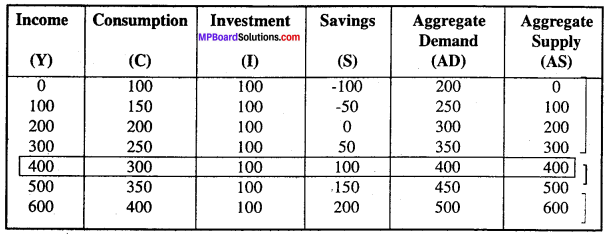
AD is smaller than AS, AD > AS
In the above aggregate table, the aggregate demand and aggregate supply are equal at Rs. 400 crores of National, Income. At this level saving is also equal to investment and any change on this level cannot be stable and remain for a long period of time.
Explanation with the help of curve:
This equilibrium between income and employment can be further explained with the help of given curves:
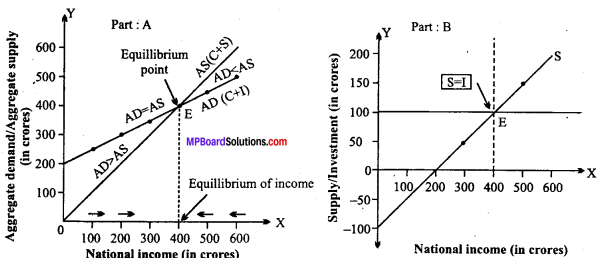
In the above figure of part-A aggregate demand (AD) cuts aggregate supply (AS) at the point E. A1 this point the equilibrium level of income and employment is determined at Rs. 400 crores. In figure of part-B show the saving and investment at the same income level.
At the equilibrium point income, saving and investment is also equal. Keynes has defined it as “Effective demand”. According to Keynes, the point at which the aggregate demand intersects with the aggregate supply the price of that point is called effective demand. According to Keynes, for equilibrium full employment is necessary.
According to him determination of equilibrium is possible only at full employment level or before and after full employment also. If equilibrium is established before full employment then it is called “imperfect employment equilibrium”. The equilibrium at full employment is called “full employment equilibrium”, which is a special situation of economy of a country.
![]()
Question 5.
Write any four factors determining propensity to consume.
Answer:
The following factors determines, propensity to consume:
1. Money income:
If there is increase in money income, the consumption expenditure will also increase.
2. Distribution of income:
If the income reaches the hands of poor people in stead of rich people, the consumption expenditure will rise. The consumption expenditure will reduce if the distribution of income is unequal and it will rise if the distribution of income is equal.
3. Fiscal policy:
The propensity to consume will decrease if more indirect taxes are imposed and it will rise if more direct taxes all imposed indirect taxes adversely affect the poor while direct taxes adversely affect the rich.
4. Future expectation of rise or fall in prices:
If the prices are expected to rise in future, present consumption will be more. If the prices expected to fall down in future present consumption will be less.
5. Effect of exposure:
The countries where goods are exposed or advertise more, there propensity to consume is more.
Question 6.
Throw light on the concept of full employment and involuntary unemployment.
Answer:
(1) Full employment: The term “Full employment” signifies the situation. Where in all the persons willing to work at existing rate of remuneration are getting employment. Full employment never means zero unemployment. According to Ward “Full employment refers to level of employment associated with a normal level of unemployment.” The full employment equilibrium refers to that equilibrium which is arrived at by equality of aggregate demand and aggregate supply.
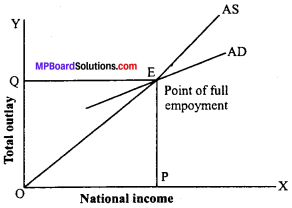
The point of full employment will be where, the aggregate demand curve and the aggregate supply curve both intersect each other as is shown in the following diagram. Here, at O.P. (National income level) aggregate demand curve and aggregate supply curve both meet at point E. Hence, EP is represents full employment and E is called the point of full employment equilibrium.
(2) Involuntary unemployment or Under employment:
The term “unemployment” refers to that situation where in all the persons are willing to work at existing rate of remuneration do not get employment. It signifies Y the state where the available resources are not fully utilized. The aggregate supply of goods and services is perfectly elastic.
In other words the supply of can change when there is a change in demand. In this situation, the equilibrium level of output and employment will depend on the aggregate demand. It is a situation below full employment. The aggregate anticipated expenditure is less than the available aggregate output.
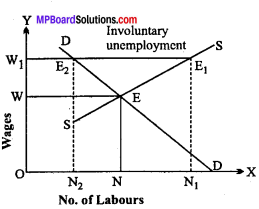
This can be explained by diagram:
In diagram point ‘E’ is of full employment. At this point the demand of labours is equal to the supply of labours. On OW1 . wages ON1 labours are willing to work. Enterprises requires only ON2 labour demand. Thus N1 N2 will be known as involuntary employment.
![]()
Question 7.
What do you mean by deficit demand? What is the impact of deficient demand on production output, employment on prices.
Answer:
Deficit demand is a situation where the equilibrium between aggregate demand and aggregate supply takes place at a point below the full employment point. It is also known as under employment equilibrium. In other words deficient demand refers to the situation where available aggregate output exceeds the anticipated aggregate expenditure.
In such situation the available resources are not fully utilized. This shortage of aggregate demand does not enable us to reach the level of full employment so it is called deficient demand.
The impact of deficient demand can be studied under the following heads:
I. Impact of deficit demand on output:
if the aggregate demand is less in compare to the aggregate supply is an economy it means that what ever goods and services are available in the country are not fully demanded by people. This situation has impact on total output.
The impact are as follows:
- Due to less demand the producers will be forced to reduce the production.
- In such situation producers will not be able to utilize their present production capacity fully.
- Thus factors of production will not be fully utilized by the producers.
- Due to the situation of deficient demand the present existing firms will stop their work and new firms will not enter in the market.
- The cost of production will be high in this situation.
II. Impact of deficit demand on employment:
In an economy when the situation of ‘ deficit demand arises then it affect the employment situation also. The impact is seen in the following way:
- Due to shortage of demand the producers will reduce the production and thus less no. of workers will be required.
- If in the country there is a situation of partial employment then some people will have to lose their jobs.
- If in a country already the situation of under employment prevails then the condition will became from bad to worse.
III. Impact of deficit demand on prices:
When the situation of deficit demand arises there is impact on prices of goods also. The impact is as follows:
- If aggregate demand is less as compared to aggregate supply then in the country price level will be less.
- Due to reduction in price level the difference of profit to the producers will be less.
- The consumers will get the profit of this situation because they will get the goods and services at less price.
![]()
Question 8.
Explain the determination of effective demand.
Answer:
The principle of effective demand is the foundation stone of income and employment theory of Prof. Keynes. According to Keynes in an economy, employment depend on effective demand. Due to reduction in effective demand unemployment spreads in a country and only by increasing effective demand unemployment can be removed. By effective demand we mean the amount of money which people of a country spent on consumption and investment in a specific time. That level of demand is effective which is equal to aggregate supply.
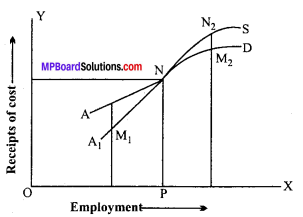
According to Keynes, “The point of aggregate demand at which the curve of aggregate curve intersect the price at that point is called the effective demand. Here, AD curve represent aggregate demand function and A1S curve represent aggregate supply function, AD and A1S curves meet each other at N point which is a point of effective demand. At this point OP is the employment available and here OQ = receipts = costs. At any other point two curves cannot be in equilibrium. Here AD and AS are exactly equal.
![]()
Question 9.
Write the importance of effective demand.
Answer:
Following are the importance of effective demand:
(1) Determination of employment:
According to Keynes, the employment depend on effective demand and aggregate demand is equal to aggregate supply. Thus effective demand determines the quantity of demand on one hand and on the other hand the amount of income produced by it.
(2) Receiving income:
Effective demand also determines income. Labour get employment due to effective demand. Employment gives wages to labours. This is the effect of effective demand only.
(3) Importance of investment:
Effective demand also determines investment. Due to it producers are motivated to produce more. To increase production the investors and producers are encouraged to invest in new-new capital resources.
(4) The concept of full employment is rejected:
The concept of full employment is fully rejected with the help of effective demand. In practical life this concept is not accepted because employment is created by effective demand. When effective demand increases the employment is also created.
By getting employment the situation of employment is improved. By decrease in effective demand the level of employment reduces and unemployment spread in the society. Thus retrenchment of people is done even if he is capable. i > o the concept of full employment is not accepted.
Question 10.
What do you mean by excess demand? Write it causes.
Answer:
Meaning: When planned aggregate expenditure (i.e., aggregate demand) is greater than the aggregate supply (i.e., available output) at full employment level, the situation is termed as excess demand. When the anticipated expenditure in the economy is more than the value of full employment output, there exists a gap between aggregate demand and aggregate supply.
The gap is technically termed as inflationary gap. (Excess demand or Inflationary gap is a situation of escalating expenditure in the economy without a rise in the flow of goods and services.
Excess demand = Inflationary gap = ADE – ADF = FC.
Causes of Excess demand:
Excess demand may caused by several factors. Important among them are mentioned below:
- Excess demand may be caused by an increase in money supply due to deficit financing.
- It may also be caused by increase in consumption demand due to rise in propensity to consume.
- An increase in autonomous investment without corresponding increase in savings may cause excess demand.
- A fall in the supply of consumer goods and services due to diversion of resources from the production of consumer goods to the production of defense goods, will result in excess demand. The available output for the households will not be sufficient to meet their aggregate demand.
- Excess demand may also arise when demand for exports increases.
![]()
Question 11.
Explain the employment principle by Keynes.
Answer:
Keynes, in his book ‘National Principle had analyzed income and employment principle. He propounded this principle during the depression period of 1930. According to his theory the level OL. Income and employment is maintained by effective demand. In the absence of effective demand unemployment increases. Effective demand is determined by
- Aggregate demand,
- Aggregate supply.
The point where AD = AS, at this point Effective demand is determined. At this point the amount of production, and level of employment is determined. This can be explained by chart:
Effective Demand = Total production
Total income = Employment
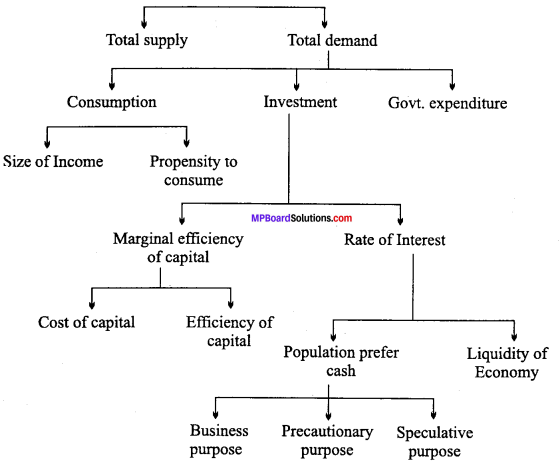
Question 12.
What do you mean by Deficit demand? What are its causes?
Or
State any five causes of Deficit demand.
Answer:
Deficit demand is a situation where the equilibrium between aggregate demand and aggregate supply takes place at a point below the full employment point. It is also known as under employment equilibrium. In other words deficient demand refers to the situation where available aggregate output exceeds the anticipated aggregate expenditure.
In such situation the available resources are not fully utilized. This shortage of aggregate demand does not enable us to reach the level of full employment so it is called deficient demand. Cause of Deficient demand: In any economy the situation of Deficient demand arises due to following reasons:
- Fall in public expenditure,
- Reduction in export demand,
- Fall in investment demand.
- Fall in disposable income,
- Fall in consumption demand,
- Fall in supply of money,
- Fall in creation of credit.
![]()
Question 13.
State measures to correct excess demand.
Answer:
1. Bank rate:
The rate at which the central bank lends money to its member banks is called bank rate. In a situation of excess demand, the central bank should raise the bank rate. Increase in bank rate will automatically lead to increase in banks lending rates to their borrowers. This, in turn, will reduce the volume of banks loans and advances. Consequently, expenditure on both consumption and investment is reduced.
2. Increasing the reserve ratio:
Reserve ratio refers to a minimum percentage of deposits of a commercial bank in the Reserve Bank. If the reserve ratio is increased it will reduce the credit creation capacity of the banks. When there is a situation of excess demand, central bank can increase this ratio and thereby cash resources of the banks can be reduced. This will force the commercial banks to contract credit.
3. Open market operations:
The buying and selling of government securities and bonds in the open market by the central bank are called open market operations. In the time of excess demand, central bank sells government securities to commercial banks or to their customers. This will reduce the cash reserves with the commercial banks directly and indirectly thereby affecting their capacity to make loans. It will reduce the cash reserves of the commercial banks.
4. Reducing credit Inflation:
To reduce the excess demand or to reduce inflation it is essential to reduce credit inflation. By selling securities, by increasing bank rate by central bank credit inflation can be reduce.
5. By taking old currency and circulating new currency:
In situation of excess demand the government cancel the old currency and in place of it new currency was intro duced for circulation.